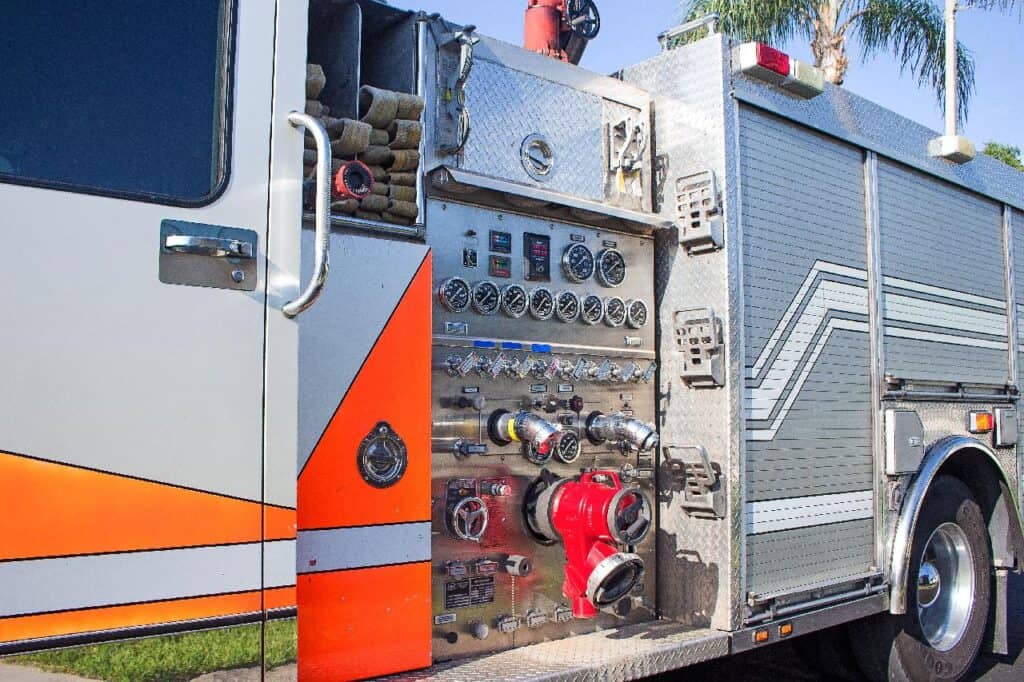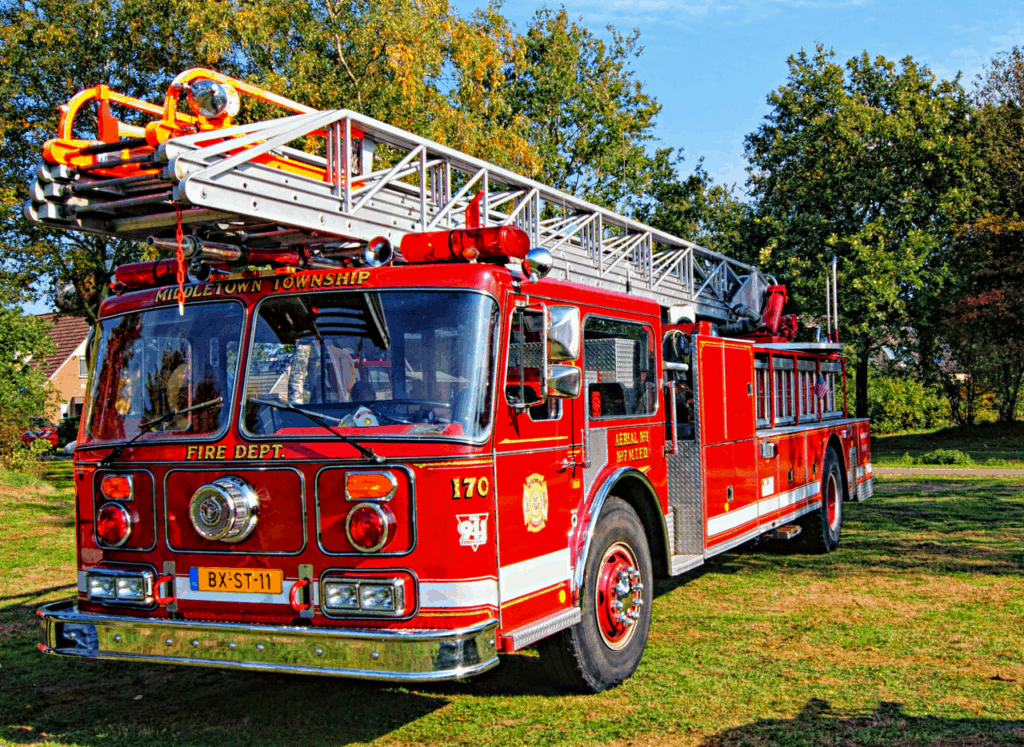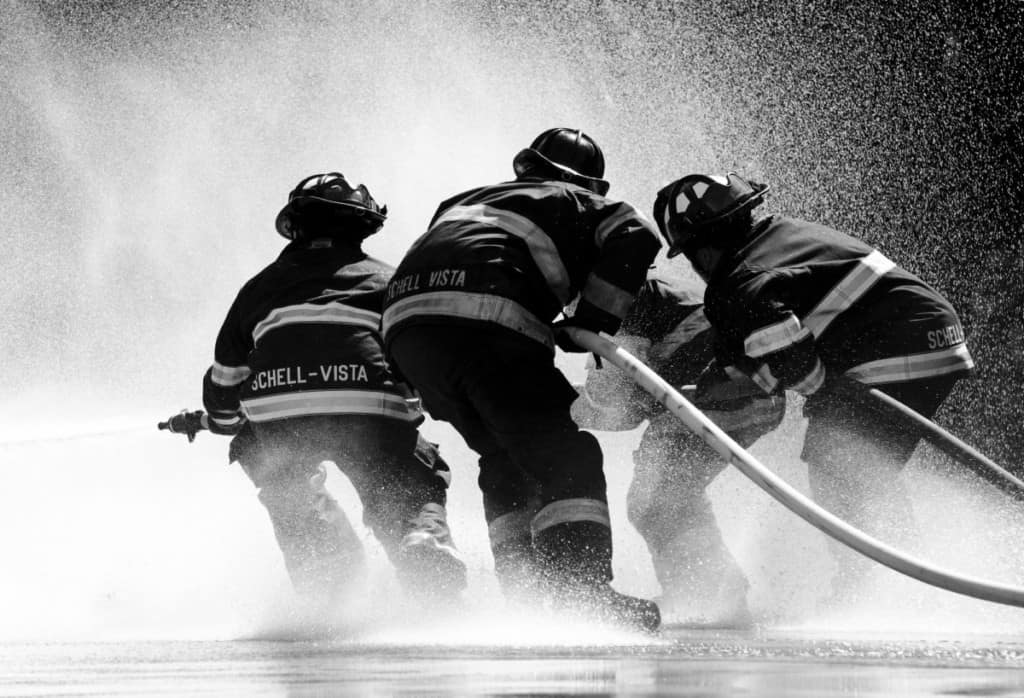What’s the difference between a Fire Engine and a Fire Truck? People often wonder if they are actually the same thing or which one is which? Are they designed for different tasks? Fire engine vs. Fire truck- are they really the same?
The difference between a Fire Engine and a Fire Truck is that an engine is equipped with water, a pump, and hoses to put out the fire, whereas a truck is designed with a large aerial ladder on the top and is responsible for functions like ventilation, rescue, and forcible entry.
There is a lot more than that differentiating an engine from a truck. Keep reading to learn more about the different characteristics and operations or uses of each apparatus.
Your # 1 priority is keeping your family safe. As a firefighter, I recommend everyone has updated smoke detectors that don’t require battery changes, like these ones from Kidde, a fire extinguisher, like this one from Amerex, and a fire escape ladder if you have bedrooms above the first floor, I recommend this one from Hausse.
Also read: How Wide and Long Is A Fire Truck/Engine?
Fire Engines Characteristics

The fire engine, which is also referred to as a “Pumper”, is the most common type of fire apparatus. This is what you will see most often driving around.
Fire engines, while still quite large, are usually noticeably smaller than fire trucks. They are designed to actually suppress or put out the fire. Obviously, this is the fundamental part of fighting a fire. There are three main components that fire engines need to perform their primary task of fighting the fire.
The first component the fire engine is equipped with is a water tank of varying sizes (usually 300-500 gallons) to allow the firefighters to start putting out the fire while an alternate water supply is accessed. The most common being connecting supply hose to a fire hydrant. They are also able to draft or pull water out of a lake, pond, reservoir or even a pool.
FUN FACT: The 300-500 gallon water tank can be emptied in as little as 20-30 seconds, depending on what type of hose and nozzle is being used to attack (put out) the fire.
The second component is a fire pump. The most common being a centrifugal pump.
“A centrifugal pump is a mechanical device designed to move a fluid by means of the transfer of rotational energy from one or more driven rotors, called impellers.”
Michael Smith Engineers Ltd.
This basically means that a spinning propeller creates pressure to move the water. This pump is what powers the whole firefighting operation. It can take water from a static (not moving) or pressurized source (like a fire hydrant) and increase the pressure to move large volumes of water to the fire.
If you want a more in-depth explanation of what a centrifugal pump is and how it works, check out this cool article that explains it really well.
The third component of a fire engine is hose. We need a portable (we can’t be installing water mains and pipes while fighting a fire) way to move the water from the water source (water tank, hydrant, pool, etc.) to the pump and then from the pump to the nozzle and onto the fire.
Fire engines have certain requirements for how much hose they need to have, depending on the type of engine.
As an example, at my department, our fire engines have 600 feet of 5 inch supply hose (for getting water from the hydrant to the pump), 1450 feet of 2-1/2 inch hose (used for supply or attack) and 800 feet of 1-3/4 inch attack line. These are stored all over the engine in different configurations for different purposes.
In addition to the key components of the engine, most fire apparatus are like big toolboxes and carry a ton of different tools and equipment. What each engine carries can be very different depending on the needs of the area that they serve. Some common tools carried are:
- Ground ladders usually from 10-28 feet long
- Different types of nozzles
- Hand tools like axes, pike poles, halligans, sledgehammers
- Air packs or SCBA’s (Self Contained Breathing Apparatus)
- Emergency medical equipment such as cardiac monitors, backboards, IV’s and medications
- Thermal imaging cameras
- Rescue ropes
Also read: What Is A (1, 2, 3, 4, 5) Alarm Fire? Firefighter Answers
Fire Truck Characteristics

While most people refer to any fire apparatus they see as a fire truck, it is actually the less commonly seen of the two apparatus. The fire truck is considerably bigger and longer than most engines. The crew can be referred to as a truck of ladder company.
They are usually less involved in the actual putting the fire out and more in all the other functions that need to take place at a fire. In general, fire trucks don’t have a pump or water tank, though there are some specialty trucks (called Quints) that do. Many cities don’t even have a fire truck at all and the typical duties of a truck company must be done by the engine firefighters.
The main component of the fire truck is the large, hydraulic powered, aerial ladder mounted on top. This ladder is usually 70 – 120 feet when fully extended. This can be used for a variety of purposes and really comes in handy with fires and rescues in multi-story buildings.
In order to be able to safely support the aerial ladder, the fire truck must have ground support stabilizers or outriggers. These 4 arms extend from beneath the truck, powered by hydraulics, to the ground. They even lift the truck partially off the ground to create a larger base of support to be able to safely load the ladder with firefighters and equipment, without the truck tipping over.
Just like a fire engine, a fire truck is a big toolbox on wheels. Because of their bigger size, they can carry even more tools and equipment then engines. Though the exact tools and layout can vary widely, some other common things found on a fire truck are:
- Power tools like chainsaws, circular saws, hydraulic spreaders and cutters (commonly called “Jaws-of-Life”)
- Specialty rescue equipment like ropes, harnesses, and belay devices
- Airbags for lifting heavy objects
- High power electric fans
- As well as most of the same hand tools, ladders and equipment as an engine
Also read: How Much Do Fire Trucks Cost? Apparatus Types and Prices
Fire Engine Operations

Engines are designed for, “putting the wet stuff on the red stuff”, as they say. Though fire engines and trucks both need to be prepared to respond to all different types of calls, when it comes to fighting fires, they are each made to handle specific tasks. With its water, pump, and hose, engines are perfectly equipped to knock down the fire.
The basic idea for fighting a structure fire (though it can vary widely for each type of fire) is to move as a team, using water to cool, find the source of the fire and directly put water on the seat or base of the fire.
This process is very dynamic and there are many steps, hazards and variables to do this safely and effectively.
Also read: How Much Water Does A Fire Truck/Fire Engine Hold?
Fire Truck Operations

Though firefighters on the truck can still be a part of the fire attack (putting out the fire), they are more commonly involved with ventilation, search and rescue, forcible entry, and salvage.
Ventilation is the process of removing smoke, heat and toxic gases from the space that is on fire. This can be accomplished vertically through a hole in the roof or horizontally through windows and doors. This makes the space more tenable (safe to be in) and improves visibility for both victims and for the firefighters inside.
Search and rescue is simply locating and removing victims who are threatened or overcome by the smoke and fire. While this process is simple, it is almost never easy. There are many hazards in a fire that complicate this process greatly. Rescue can also be very different in a non-fire emergency, like a technical cliff or trench rescue. This is also frequently performed by the truck firefighters.
Forcible entry is finding a way to get inside a house or other building when it’s not easy to do so (locked doors, barred windows, etc.). It can be anything from kicking down a door to cutting open a wall with a saw. This can be done just to gain access or to allow victims and firefighters another way out.
As firefighters, we do the best we can, to not only save any lives threatened but to try to protect property and belongings when safe to do so. Salvage is the process of protecting belongings and personal items in the fire from the damage of fire, smoke and even the water used to extinguish the fire. This can be done by removing items from the fire or by protecting them with special tarps and covers.
Do Fire Trucks Carry Water?
Traditionally fire trucks do not have a water tank or pump for extinguishing fire.
However, there are specialty trucks called “Quints” that have an aerial ladder, water tank, water pump, hose and ground ladders. These are basically a combo of an engine and a truck.

